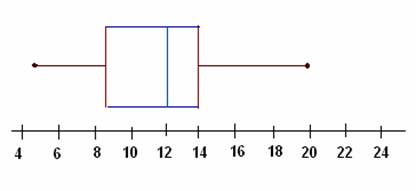Box Plots
The box plot is also known as a box-and-whisker diagram. This plot splits the data into five parts: namely the smallest quantity, the lower quartile, the median quartile, the upper quartile and the largest quantity. A quartile represents 25% of the data
Example:
Draw the box and whisker plot for the data 12, 13, 5, 8, 9, 20, 16, 14, 14, 6, 9, 12, 12.
Sol:
Sort the data in ascending order Þ 5, 6, 8, 9, 9, 12, 12, 12, 13, 14, 14, 16, 20.
Now, the median is the mid-value = 12, the median is the middle score of the data once sorted
Next we need to find the lower median, i.e. the median for the numbers below 12 (normal median) in the sorted number list, i.e. for the sub-list 5, 6, 8, 9, 9, 12.
Lower median = = = 8.5, since there are an even number of scores, the middle score (median) is the number between the two middle scores
Similarly, the upper median is the median of the entries above 12 in the sorted list.
Upper median = = = 14
The smallest number in the list = 5, and the largest number in the list = 20.
Now, let us plot these values on the number line:

This is a box whisker plot; the left and right end points show the smallest and largest quantities of the data respectively. The two lines immediate to the end points are the lower median and upper median.
The line drawn in the middle of the box indicates the normal median of the data.
Try these questions :
- A set of data was plotted in a box plot. What was the median of the lower half of the data set?

- −2
- 0
- 3
- 4
Answer: A
The lower half median is indicated by the first line of the box part of the plot; hence -2.
- In a box plot, the lower quartile contains what percentage of the data?
- None
- 25%
- 50%
- 75%
Answer: B
Each quartile of a box plot contains 25% of the data.